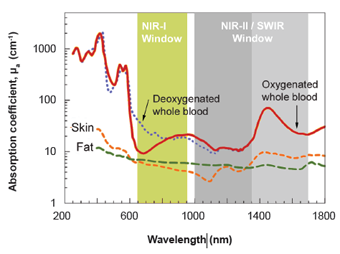SWIR/NIR-II Imaging
Near-infrared (NIR) and shortwave infrared (SWIR) fluorescence is rapidly being used within medical and biological research as wavelengths in the NIR can penetrate soft tissue producing high resolution images of in vivo structures.
The second NIR window (NIR-II, 900 – 1700 nm) is of special interest as it is able to penetrate deeper into soft tissue with reduced scattering and less autofluorescence. This window also takes advantage of the water transparency window, a wavelength range in which water absorption is negligible (800 – 1400 nm).
NIR-II imaging relies on NIR-II emitting fluorophores, which are undetected by traditional silicon based sensors. The band gap within silicon sensors means there is a minimum amount of energy required to absorb a photon. The energy of NIR-II photons (or any above 1100 nm) is too low to produce this energy. Therefore InGaAs sensors are required.

Cameras for SWIR/NIR-II Imaging

NIRvana Family
Typical silicon based sensors are not sensitive to light above 1100 nm, so are unable to image in the SWIR/NIR-II. Therefore, InGaAs cameras are required. The NIRvana family of focal plane array InGaAs cameras offer high sensitivity in the 900 – 1700 nm range, ideal for capturing low-light NIR-II/SWIR fluorescence.
Noise is reduced with the NIRvana as it is thermoelectrically cooled, with temperatures reaching as low as -85℃, providing the lowest level of dark noise to enhance SWIR/NIR-II imaging. The cryogenically cooled NIRvana LN camera is also available, reaching temperatures of -190℃.
With high signal-to-noise ratios up to 250 full frames per second, the NIRvana family allows for fast capture of fluorescence even with extremely low exposure times.
PyLoN IR
The PyLoN IR is an InGaAs camera designed for spectroscopy, offering extremely low noise over the spectral range of 800-2200 nm. The PyLoN IR is cryogenically cooled, providing low dark current and reduced read noise – ideal for SWIR/NIR-II spectroscopy limited by noise.
The PyLoN IR also provides flexible readout speeds, enabling both high spectral speeds (<6600 spectra/sec) or low read noise dependent on the specific SWIR/NIR-II sample, ranging from 4-50 kHz.

